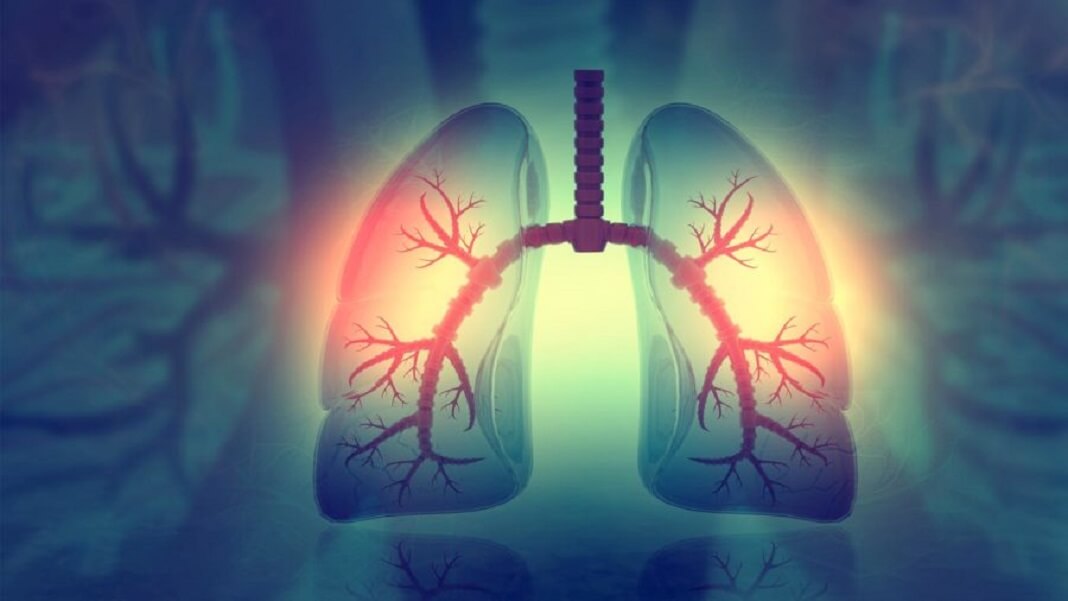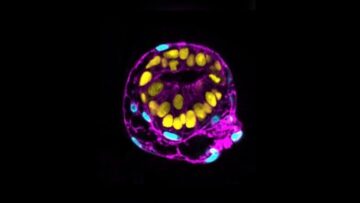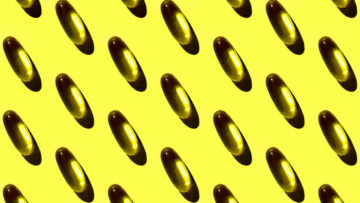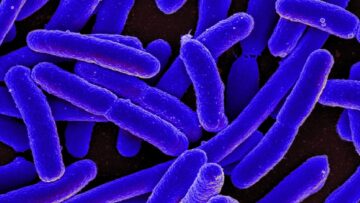
We’ve all been more aware of lung health since Covid-19.
However, for people with asthma and chronic obstructive pulmonary disease (COPD), dealing with lung problems is a lifelong struggle. Those with COPD suffer from highly inflamed lung tissue that swells and obstructs airways, making it hard to breathe. The disease is common, with more than three million annual cases in the US alone.
Although manageable, there is no cure. One problem is that lungs with COPD pump out tons of viscous mucus, which forms a barrier preventing treatments from reaching lung cells. The slimy substance—when not coughed out—also attracts bacteria, further aggravating the condition.
A new study in Science Advances describes a potential solution. Scientists have developed a nanocarrier to shuttle antibiotics into the lungs. Like a biological spaceship, the carrier has “doors” that open and release antibiotics inside the mucus layer to fight infections.
The “doors” themselves are also deadly. Made from a small protein, they rip apart bacterial membranes and clean up their DNA to rid lung cells of chronic infection.
The team engineered an inhalable version of an antibiotic using the nanocarrier. In a mouse model of COPD, the treatment revived their lung cells in just three days. Their blood oxygen levels returned to normal, and previous signs of lung damage slowly healed.
“This immunoantibacterial strategy may shift the current paradigm of COPD management,” the team wrote in the article.
Breathe Me
Lungs are extremely delicate. Picture thin but flexible layers of cells separated into lobes to help coordinate oxygen flow into the body. Once air flows through the windpipe, it rapidly disperses among a complex network of branches, filling thousands of air sacs that supply the body with oxygen while ridding it of carbon dioxide.
These structures are easily damaged, and smoking is a common trigger. Cigarette smoke causes surrounding cells to pump out a slimy substance that obstructs the airway and coats air sacs, making it difficult for them to function normally.
In time, the mucus builds a sort of “glue” that attracts bacteria and condenses into a biofilm. The barrier further blocks oxygen exchange and changes the lung’s environment into one favorable for bacteria growth.
One way to stop the downward spiral is to obliterate the bacteria. Broad-spectrum antibiotics are the most widely used treatment. But because of the slimy protective layer, they can’t easily reach bacteria deep inside lung tissues. Even worse, long-term treatment increases the chance of antibiotic resistance, making it even more difficult to wipe out stubborn bacteria.
But the protective layer has a weakness: It’s just a little bit too sour. Literally.
Open-Door Policy
Like a lemon, the slimy layer is slightly more acidic compared to healthy lung tissue. This quirk gave the team an idea for an ideal antibiotic carrier that would only release its payload in an acidic environment.
The team made hollow nanoparticles out of silica—a flexible biomaterial—filled them with a common antibiotic, and added “doors” to release the drugs.
These openings are controlled by additional short protein sequences that work like “locks.” In normal airway and lung environments, they fold up at the door, essentially sequestering the antibiotics inside the bubble.
Released in lungs with COPD, the local acidity changes the structure of the lock protein, so the doors open and release antibiotics directly into the mucus and biofilm—essentially breaking through the bacterial defenses and targeting them on their home turf.
One test with the concoction penetrated a lab-grown biofilm in a petri dish. It was far more effective compared to a previous type of nanoparticle, largely because the carrier’s doors opened once inside the biofilm—in other nanoparticles, the antibiotics remained trapped.
The carriers could also dig deeper into infected areas. Cells have electrical charges. The carrier and mucus both have negative charges, which—like similarly charged ends of two magnets—push the carriers deeper into and through the mucus and biofilm layers.
Along the way, the acidity of the mucus slowly changes the carrier’s charge to positive, so that once past the biofilm, the “lock” mechanism opens and releases medication.
The team also tested the nanoparticle’s ability to obliterate bacteria. In a dish, they wiped out multiple common types of infectious bacteria and destroyed their biofilms. The treatment appeared relatively safe. Tests in human fetal lung cells in a dish found minimal signs of toxicity.
Surprisingly, the carrier itself could also destroy bacteria. Inside an acidic environment, its positive charge broke down bacterial membranes. Like popped balloons, the bugs released genetic material into their surroundings, which the carrier swept up.
Damping the Fire
Bacterial infections in the lungs attract overactive immune cells, which leads to swelling. Blood vessels surrounding air sacs also become permeable, making it easier for dangerous molecules to get through. These changes cause inflammation, making it hard to breathe.
In a mouse model of COPD, the inhalable nanoparticle treatment quieted the overactive immune system. Multiple types of immune cells returned to a healthy level of activation—allowing the mice to switch from a highly inflammatory profile to one that combats infections and inflammation.
Mice treated with the inhalable nanoparticle had about 98 percent less bacteria in their lungs, compared to those given the same antibiotic without the carrier.
Wiping out bacteria gave the mice a sigh of relief. They breathed easier. Their blood oxygen levels went up, and blood acidity—a sign of dangerously low oxygen—returned to normal.
Under the microscope, treated lungs restored normal structures, with sturdier air sacks that slowly recovered from COPD damage. The treated mice also had less swelling in their lungs from fluid buildup that’s commonly seen in lung injuries.
The results, while promising, are only for a smoking-related COPD model in mice. There’s still much we don’t know about the treatment’s long-term consequences.
Although for now there were no signs of side effects, it’s possible the nanoparticles could accumulate inside the lungs over time eventually causing damage. And though the carrier itself damages bacterial membranes, the therapy mostly relies on the encapsulated antibiotic. With antibiotic resistance on the rise, some drugs are already losing effect for COPD.
Then there’s the chance of mechanical damage over time. Repeatedly inhaling silicon-based nanoparticles could cause lung scarring in the long term. So, while nanoparticles could shift strategies for COPD management, it’s clear we need follow-up studies, the team wrote.
Image Credit: crystal light / Shutterstock.com
- SEO Powered Content & PR Distribution. Get Amplified Today.
- PlatoData.Network Vertical Generative Ai. Empower Yourself. Access Here.
- PlatoAiStream. Web3 Intelligence. Knowledge Amplified. Access Here.
- PlatoESG. Carbon, CleanTech, Energy, Environment, Solar, Waste Management. Access Here.
- PlatoHealth. Biotech and Clinical Trials Intelligence. Access Here.
- Source: https://singularityhub.com/2024/02/12/an-antibiotic-you-inhale-can-deliver-medication-deep-into-the-lungs/
- :has
- :is
- :not
- $UP
- 98
- a
- ability
- About
- Accumulate
- added
- Additional
- AIR
- airways
- All
- alone
- already
- also
- among
- an
- and
- annual
- Antibiotics
- apart
- appeared
- ARE
- areas
- article
- At
- attract
- Attracts
- aware
- Bacteria
- barrier
- because
- become
- been
- Bit
- Blocks
- blood
- blood vessels
- body
- both
- branches
- Breaking
- BREATHE
- Broke
- bubble
- bugs
- builds
- but
- by
- CAN
- carbon
- carbon dioxide
- carriers
- cases
- Cause
- causes
- causing
- Cells
- Chance
- Changes
- charge
- charged
- charges
- clean
- clear
- Common
- commonly
- compared
- complex
- concoction
- condition
- Consequences
- controlled
- coordinate
- could
- COVID-19
- credit
- cure
- Current
- damage
- Dangerous
- Days
- dealing
- deep
- deeper
- defenses
- deliver
- describes
- destroy
- destroyed
- developed
- difficult
- DIG
- directly
- Disease
- dish
- dna
- Dont
- Door
- doors
- down
- downward
- Drugs
- easier
- easily
- effect
- Effective
- effects
- encapsulated
- ends
- engineered
- Environment
- environments
- essentially
- Even
- eventually
- exchange
- extremely
- far
- favorable
- fight
- filling
- flexible
- flow
- Flows
- fluid
- For
- forms
- found
- from
- function
- further
- gave
- genetic
- get
- given
- Growth
- had
- Hard
- Have
- Health
- healthy
- help
- highly
- Home
- HTTPS
- human
- idea
- ideal
- immune
- Immune system
- in
- Increases
- infected
- infection
- Infections
- infectious
- inflammation
- inflammatory
- inside
- into
- IT
- ITS
- itself
- jpg
- just
- Know
- largely
- layer
- layers
- Leads
- less
- Level
- levels
- lifelong
- like
- little
- local
- lock
- Long
- long-term
- losing
- Low
- Lungs
- made
- Making
- manageable
- management
- material
- May..
- mechanical
- mechanism
- medication
- mice
- Microscope
- million
- minimal
- model
- more
- most
- mostly
- mouse
- much
- mucus
- multiple
- Need
- negative
- network
- New
- no
- normal
- normally
- now
- of
- on
- once
- ONE
- only
- open
- opened
- openings
- opens
- Other
- out
- over
- Oxygen
- paradigm
- past
- People
- percent
- Petri
- picture
- plato
- Plato Data Intelligence
- PlatoData
- positive
- possible
- potential
- preventing
- previous
- Problem
- problems
- Profile
- promising
- Protective
- Protein
- pump
- rapidly
- reach
- reaching
- relatively
- release
- released
- Releases
- relief
- remained
- REPEATEDLY
- Resistance
- restored
- Results
- Rid
- Rise
- safe
- same
- Science
- scientists
- seen
- shift
- Short
- shutterstock
- side
- sign
- Signs
- Similarly
- since
- slightly
- Slowly
- small
- Smoke
- Smoking
- So
- solution
- some
- spiral
- Still
- Stop
- strategies
- Strategy
- structure
- structures
- Struggle
- studies
- substance
- suffer
- supply
- Surrounding
- Switch
- system
- targeting
- team
- term
- test
- tested
- tests
- than
- that
- The
- their
- Them
- themselves
- therapy
- There.
- These
- they
- thin
- this
- those
- though?
- thousands
- three
- Through
- time
- tissue
- tissues
- to
- tons
- too
- trapped
- treated
- treatment
- treatments
- trigger
- two
- type
- types
- us
- used
- using
- version
- vessels
- was
- Way..
- we
- weakness
- went
- were
- which
- while
- widely
- wipe
- with
- without
- Work
- worse
- would
- wrote
- you
- zephyrnet









